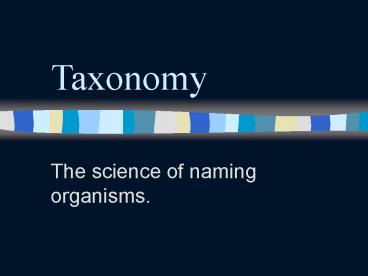Taxonomy - PowerPoint PPT Presentation
1 / 15
Title:
Taxonomy
Description:
Taxonomy The science of naming organisms. Carolus Linnaeus Described organisms with two word names, instead of polynomials Developed binomial nomenclature First word ... – PowerPoint PPT presentation
Number of Views:101
Avg rating:3.0/5.0
Title: Taxonomy
1
Taxonomy
- The science of naming organisms.
2
Carolus Linnaeus
- Described organisms with two word names, instead
of polynomials - Developed binomial nomenclature
- First word genus name
- Second word species name
3
Why binomial nomenclature?
- Much easier than a 10 word name under old
polynomial system - Same name no matter where you go
- Less confusion
- Binomial SCIENTIFIC NAME
4
Scientific Names You Need to Know
- Homo sapiens
- Canis lupus
- Felis domesticus
- Pan pan
- Always written with Genus name capitalized,
species name is lowercase. - Either italicized or underlined.
5
Taxonomic hierarchy
- Names organisms and their relationships from very
broad to very specific - Changes with additional evidence (DNA).
6
All organisms classified in a hierarchy
- Domain(broadest)
- Kingdom
- Phylum
- Class
- Order
- Family
- Genus
- Species (most specific)
7
Notes assignment
- Look up the classification for humans for all
seven hierarchies and write into your notebook.
8
What is a species?
- Biological species concept
- A group of actually or potentially breeding
natural groups that are reproductively isolated
from other groups. - Ernst Mayr, 1924
- Problems
- Hybrids
- Sterile offspring of two different species
- Asexual organisms
9
How many are out there?
- Scientists currently estimate that
- There are 10 million species worldwide
- Over 5 million live in the tropics
- Most unnamed species are small or microscopic
10
Why is taxonomy useful?
- Helps prevent confusion among scientists
- Helps to show how organisms are related
- Can be used to reconstruct phylogenies
evolutionary histories of an organism or group
11
The 3 Domain System
12
The 6 kingdoms
- Prokaryotes (Used to be 1 kingdom, Monera)
- 1. Archaebacteria
- 2. Eubacteria
- Eukaryotes
- 3. Fungi
- 4. Protista
- 5. Animal
- 6. Plantae
13
Overview of the 6 kingdoms
- 1. Archaebacteria
- Unicellular
- Live in extreme environments
- Prokaryotic
- 2. Eubacteria
- Unicellular
- Prokaryotic
- Common bacteria
14
Overview of the 6 kingdoms
- 3. Protista
- Eukaryotic
- Unicellular or colonial
- Lots of different life styles
- 4. Fungi
- Cell walls made of chitin
- Eukaryotic
- Multicellular
- External heterotrophs
15
Overview of the 6 kingdoms
- 5. Plantae
- Eukaryotic Multicellular
- Cell walls made of cellulose
- Autotrophic
- 6. Animalia
- Eukaryotic Multicellular
- No cell walls
- Internal heterotrophs































